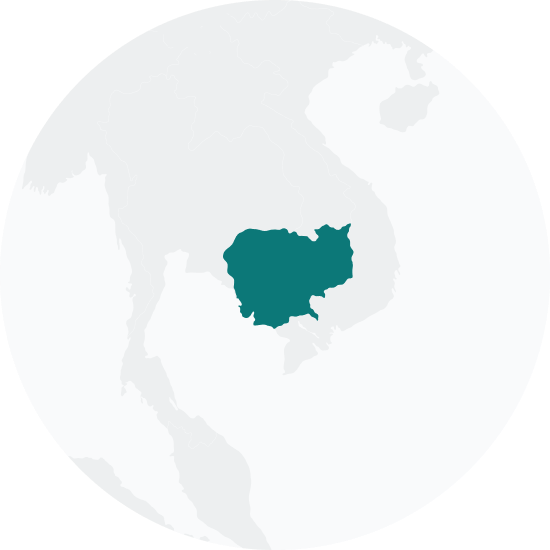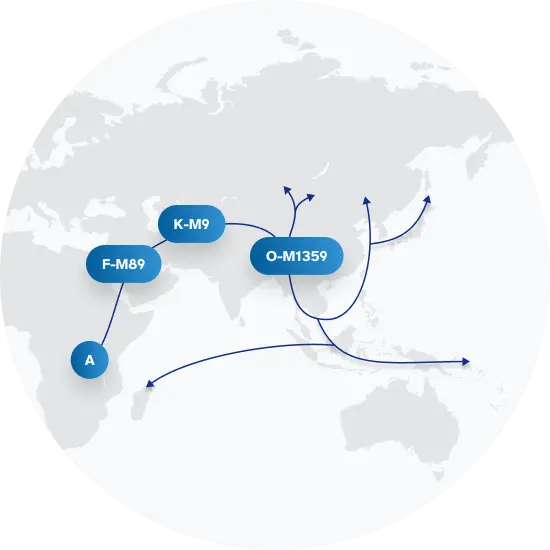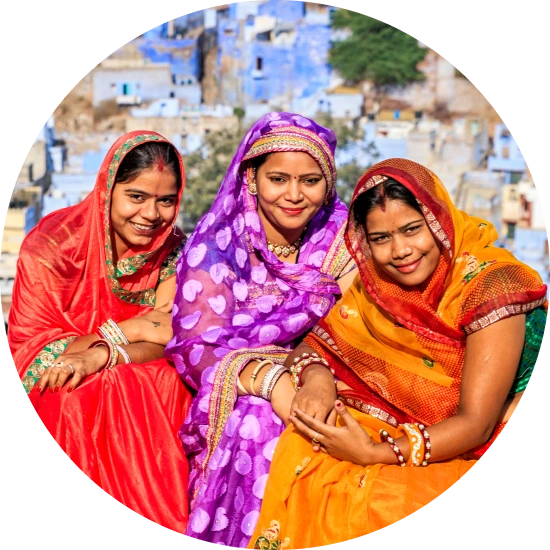Explore the Family Name Sok
How common is the last name Sok in the United States?
Based on the Decennial U.S. Census data, the surname Sok has seen an increase in popularity within the United States from 2000 to 2010. In the year 2000, Sok was ranked as the 8,271st most common surname, but by 2010 it had risen in rank to 7,295th, representing an improvement of 11.8%. The count of individuals with this surname also increased from 3,684 to 4,569 over the same decade, a growth of 24.02%. Additionally, the proportion of individuals named Sok per 100,000 citizens increased by 13.14%, moving from 1.37 to 1.55.
| 2000 | 2010 | Change | |
|---|---|---|---|
| Rank | #8,271 | #7,295 | 11.8% |
| Count | 3,684 | 4,569 | 24.02% |
| Proportion per 100k | 1.37 | 1.55 | 13.14% |
Race and Ethnicity of people with the last name Sok
In terms of ethnicity, the Decennial U.S. Census data indicates that there has been a notable shift in the ethnic identity associated with the surname Sok. From 2000 to 2010, there was an increase in individuals identifying as Asian/Pacific Islander, from 82.38% to 90.19%. However, those identifying as having two or more races decreased significantly by 69.16%, and the percentage of individuals identifying as White also dropped by 34.64%. Meanwhile, the Hispanic representation among individuals with the Sok surname experienced a substantial rise of 127.94%. The percentages of individuals identifying as Black and American Indian and Alaskan Native both declined, by 27.91% and 42.11% respectively.
| 2000 | 2010 | Change | |
|---|---|---|---|
| Asian/Pacific Islander | 82.38% | 90.19% | 9.48% |
| White | 8.14% | 5.32% | -34.64% |
| Two or More Races | 8.17% | 2.52% | -69.16% |
| Hispanic | 0.68% | 1.55% | 127.94% |
| Black | 0.43% | 0.31% | -27.91% |
| American Indian and Alaskan Native | 0.19% | 0.11% | -42.11% |
Sok ancestry composition
23andMe computes an ancestry breakdown for each customer. People may have ancestry from just one population or they may have ancestry from several populations. The most commonly-observed ancestry found in people with the surname Sok is Indonesian, Thai, Khmer & Myanma, which comprises 50.1% of all ancestry found in people with the surname. The next two most common ancestries are Vietnamese (16.4%) and Chinese (15.1%). Additional ancestries include Korean, Eastern European, French & German, British & Irish, and Indigenous American.
Ready to learn more about your ancestry? Get the most comprehensive ancestry breakdown on the market by taking our DNA test. Shop 23andMe
| ANCESTRY BREAKDOWN | COMPOSITION |
|---|---|
| Indonesian, Thai, Khmer & Myanma | 50.1% |
| Vietnamese | 16.4% |
| Chinese | 15.1% |
| Other | 18.4% |

Possible origins of the surname Sok
Your DNA provides clues about where your recent ancestors may have lived. Having many distant relatives in the same location suggests that you may all share common ancestry there. Locations with many distant relatives can also be places where people have migrated recently, such as large cities. If a large number of individuals who share your surname have distant relatives in a specific area, it could indicate a connection between your surname and that location, stemming from either recent ancestral ties or migration.
Based on 23andMe data, people with last name Sok have recent ancestry locations spanning a few countries, mostly in Cambodia, and Vietnam.
| RECENT ANCESTRY Location | Percentage |
|---|---|
| Battambang Province, Cambodia | 62.00% |
| Ho Chi Minh City, Viet Nam | 43.50% |
| Fujian, China | 39.10% |
| Guangdong, China | 39.10% |
| Zhejiang, China | 39.10% |
What Sok haplogroups can tell you
Haplogroups are genetic population groups that share a common ancestor on either your paternal or maternal line. These paternal and maternal haplogroups shed light on your genetic ancestry and help tell the story of your family.
The top paternal haplogroup of people with the surname Sok is O-F2415, which is predominantly found among people with East Asian & Indigenous American ancestry. Haplogroup O-F2415 is descended from haplogroup O-M1359. Other common haplogroups include E-M183 and O-F2859, which are predominantly found among people with European and East Asian & Indigenous American ancestry.
The most common maternal haplogroups of people with Sok surname are: M, F1a1, R. These most commonly trace back to individuals of East Asian & Indigenous American and European ancestry.
 Paternal Haplogroup Origins O-M1359
Paternal Haplogroup Origins O-M1359
Your paternal lineage may be linked to the Cham
One of the many populations harboring members of haplogroup O1b1a1a1a1 is the Cham ethnic group, a group of people who speak Austronesian languages in Mainland Southeast Asia. Austronesian languages make up a language family that is extremely large and widespread, comprising over 350 million people on islands such as Madagascar, Easter Island, and many others. However, Austronesian languages are less common on mainland Asia, with a notable exception being the Chamic language. Research suggests that ancestors of the Cham people migrated from Southeast Asian islands to the mainland around the year 500 BCE, and that early Cham populations quickly began mixing with indigenous southern Vietnamese populations. As a result, the Chamic language now has words that were borrowed from languages spoken by indigenous Vietnamese people. It is likely that an ancestral Kinh population was one of the populations that mixed with the Cham people shortly after their migration to mainland Asia.
Your maternal lineage may be linked to the ancient people of the Indian subcontinent
While Haplogroup M is widespread throughout South and East Asia, it is more diverse on the Indian sub-continent than anywhere else in the world. The high degree of diversity of M in India is likely tied to its ancient arrival here nearly 50,000 years ago. In addition to M2, which is found throughout the subcontinent, there are dozens of haplogroups branching off of M that exist in India. These branches are often connected to specific regions, tribes, or ethnic groups. For example, haplogroup M18 is found among the Oraon peoples of eastern India and Bangladesh, while haplogroup M41 is common among the Pardhan speakers of eastern India, and haplogroup M31a can be found on the Andaman Islands, just off the southeast coast of India.

What do people with the surname Sok have in common?
Spoiler alert: it's complicated. People with the same last name are usually no more genetically similar than a randomly sampled group of people from the same population. That said, people with the same surname are more likely to have similar ancestries than randomly sampled individuals. The reason is the tendency of people with similar cultural or geographical backgrounds to preferentially mate with one another. That's why people who share a surname may be more likely to share traits and tendencies in common than people within the general population. Check out the percentages below to see the prevalences of tastes, habits, and traits of people with your surname compared with prevalences among 23andMe users.
Preferences
Traits

Cheek Dimples
Small indentations that appear on the cheeks when a person smiles.
"Sok" Surname 31.2%
23andMe Users 37.6%
Habits

Learn Language As Adult
Learning a new language through formal or informal means after 18 years of age.
"Sok" Surname 35.7%
23andMe Users 25.8%
Are health conditions linked to the last name Sok?
The short answer is that, if there is an association between surname and health, it's usually more about your ancestry than your name. Individuals with a given surname are no more genetically similar than the general population but often have similar ancestries. The populations of people associated with those shared ancestries often have sets of genetic variations, also known as alleles, in common. Some of those alleles are associated with a greater likelihood of developing certain diseases.
Disease variant frequency by ancestry
Disease allele frequencies in populations associated with the surname Sok are shown below. Important Note: not everyone with a disease allele will develop these health condition




